Introduction
Understanding the intricate anatomy of the core is not just a fitness trend; it's a foundational element for achieving optimal workout results and enhancing overall well-being. With muscle groups like the rectus abdominis, transverse abdominis, and obliques playing crucial roles in stability and strength, recognizing their functions can transform how workouts are approached. This article delves into effective exercises specifically targeting the lower abs and obliques, emphasizing the importance of:
- Technique
- Variety
- Nutrition
- Recovery
By prioritizing these elements, individuals can foster a stronger core, boost performance, and cultivate a healthier lifestyle that resonates throughout their fitness journey.
Understanding Core Anatomy: The Key to Effective Workouts
To effectively train your lower ab and oblique workout, understanding the intricate anatomy of your midsection is essential. The center consists of several essential groups of tissues, including the rectus abdominis, transverse abdominis, internal and external obliques, and the pelvic floor tissues.
- Rectus Abdominis: Commonly referred to as the 'six-pack,' this structure plays a pivotal role in flexing the spine and stabilizing your torso, contributing to overall core strength.
- Transverse Abdominis: As the deepest layer of abdominal tissues, it provides crucial stability and support to the spine and pelvis, serving as a protective layer during your exercises.
- Obliques: The internal and external obliques are instrumental in trunk rotation and lateral flexion, essential for movements that involve twisting or bending.
A comprehensive understanding of these muscles not only enhances your workout effectiveness but also boosts your posture and overall fitness.
This knowledge empowers you to select exercises, including a lower ab and oblique workout, that effectively engage these areas, paving the way for better results and a strong foundation. Recent studies, such as those by Weston et al. (2013), which included 36 participants (EG = 18 and CG = 18), and McGill & Marshall (2012), have demonstrated that targeted training of the central muscles can significantly improve performance metrics, including balance and strength.
Furthermore, the case study titled 'Relationship between Cross-Sectional Area and Function of Central Muscles' illustrates the correlation between the cross-sectional area (CSA) of central muscles and their functions, showing that while central training enhances muscle hypertrophy and strength, it may not necessarily improve endurance. As fitness trainers emphasize, concentrating on central strength is vital—Calatayud et al. noted that suspended push-ups elicit the greatest activity in both the rectus abdominis and external obliques.
By prioritizing core training, you foster an environment of well-being and performance enhancement that your team will undoubtedly appreciate.
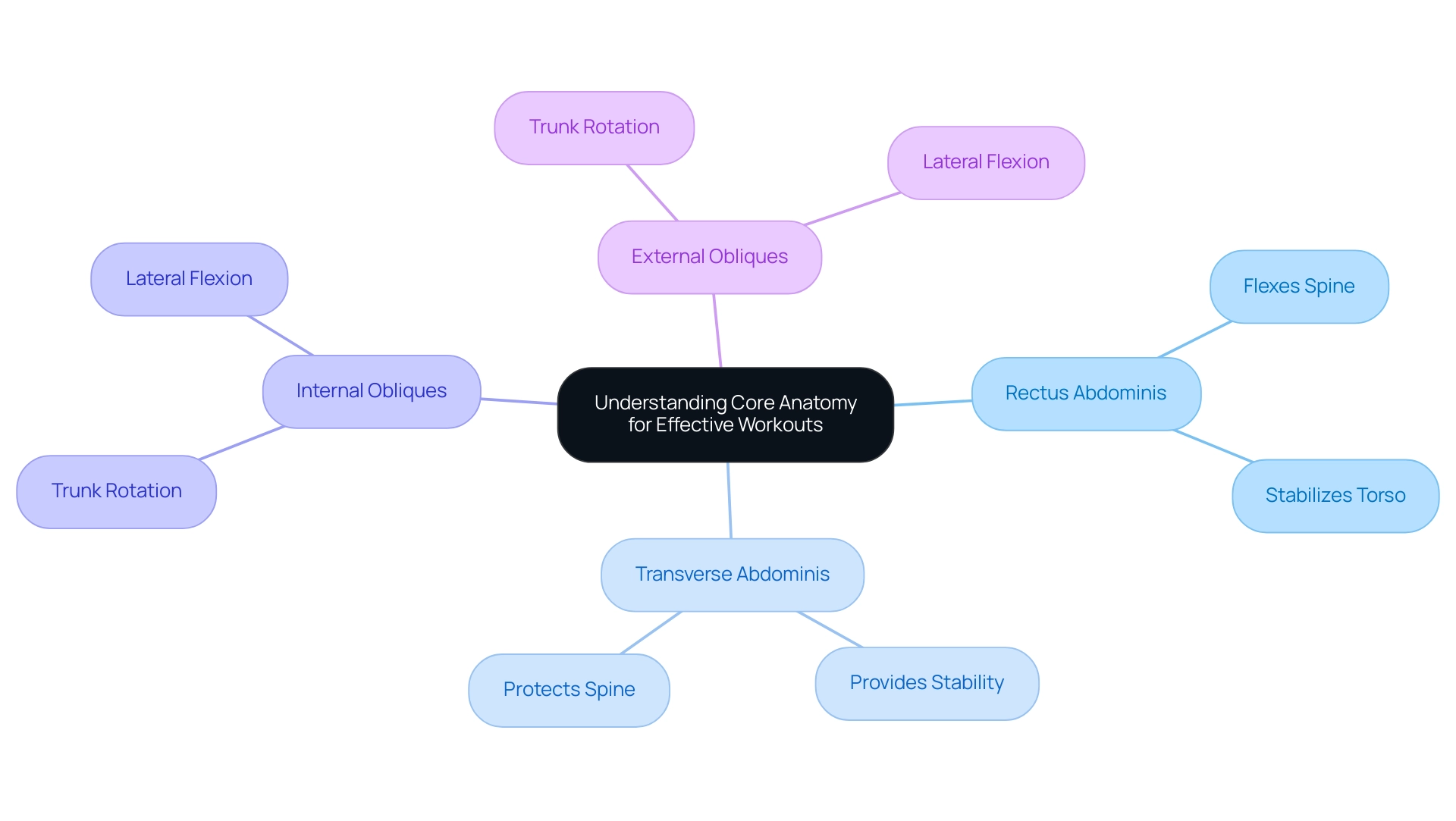
Essential Exercises for Lower Abs and Obliques: A Step-by-Step Approach
To effectively target your lower abs and obliques, consider incorporating the following essential activities into your fitness routine:
-
Reverse Crunches:
- Begin by lying on your back with your knees bent at a 90-degree angle.
- Engage your lower abs to lift your hips off the ground, curling your pelvis toward your chest.
- Slowly lower your hips back down and repeat for 10-15 reps. This lower ab and oblique workout not only strengthens your abdominal muscles but also minimizes spinal flexion, making it easier on your back. If you experience sharp pain during this activity, stop immediately and consider consulting a certified personal trainer, especially if you are new to fitness or have any injuries.
-
Bicycle Crunches:
- Lie on your back with your hands positioned behind your head and legs lifted off the ground.
- Bring your right elbow toward your left knee while straightening your right leg.
- Alternate sides in a pedaling motion for 15-20 reps. This dynamic move is excellent for engaging the obliques and can be included in a lower ab and oblique workout to improve stability.
-
Plank with Hip Dips:
- Start in a plank position with your forearms resting on the ground.
- Rotate your hips to one side, dipping them toward the floor, then return to the center and repeat on the opposite side.
- Aim for 10-15 dips on each side. This activity not only tests your center but also incorporates rotational movement, which is essential for a lower ab and oblique workout.
-
Side Plank:
- Position yourself on your side, supporting your body with your elbow.
- Lift your hips off the ground, forming a straight line from your head to your heels.
- Hold this position for 20-30 seconds on each side. The side plank is an effective method to enhance stability and strength, making it a valuable exercise for your lower ab and oblique workout.
To achieve the best results, incorporate a lower ab and oblique workout into your routine 2-3 times a week. Consistency is key to strengthening your core and enhancing overall fitness. As noted by the author of a recent study, for optimal effectiveness, consider adding a variety of top-rated activities to your daily regimen. This corresponds with knowledge acquired from my experience with planking daily for two weeks, which highlighted the significance of varied exercises. Let's dedicate ourselves to prioritizing these fundamental workouts—your body will appreciate it!
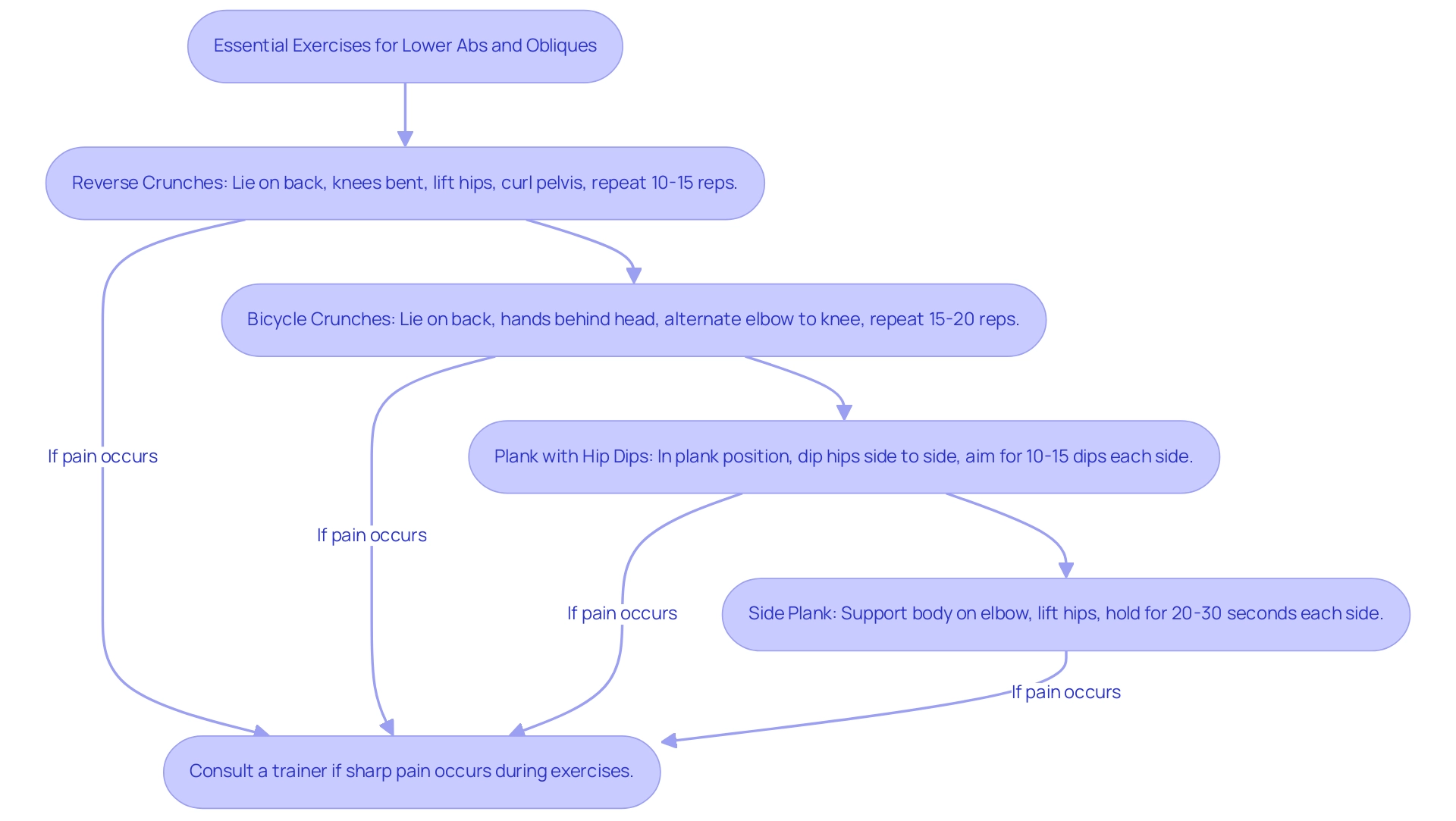
Mastering Technique: Ensuring Safety and Effectiveness in Workouts
To ensure the safety and effectiveness of your lower ab and oblique workouts, consider implementing the following essential techniques:
- Engage Your Core: Activate your core muscles before initiating any exercise. This foundational step stabilizes your spine and maximizes muscle engagement, setting the stage for a productive workout.
- Maintain Proper Alignment: When engaging in activities like crunches or planks, it’s crucial to keep your body aligned. Avoid overarching your back or allowing your hips to sag, as proper alignment prevents strain and enhances effectiveness.
- Control Your Movements: Emphasize slow and controlled movements rather than hurrying through your routines. Research indicates that participants with over five years of CrossFit experience had a low injury incidence rate of 0.25 per 1000 hours, demonstrating the importance of careful execution in reducing injury risk.
- Listen to Your Body: Pay attention to your body’s signals. If you feel pain—distinct from normal muscle fatigue—stop the activity and reassess your form or consult with a fitness professional to ensure you're performing safely.
By mastering these techniques, you not only enhance the effectiveness of your exercises but also build confidence in your approach. Implementing these practices can lead to significant improvements in performance, as evidenced by the case study titled "Intervention Impact on Injury Rates," which showed substantial reductions in injuries, particularly in back and upper extremity areas. As emphasized by specialists such as Malliaropoulos et al., concentrating on core engagement through activities that actively lengthen the hamstrings is essential for overall safety, underscoring the necessity for a holistic approach to core training that enhances athletic performance and reduces injuries.
Prioritize these strategies to foster a healthier, injury-free training environment for yourself and your team.
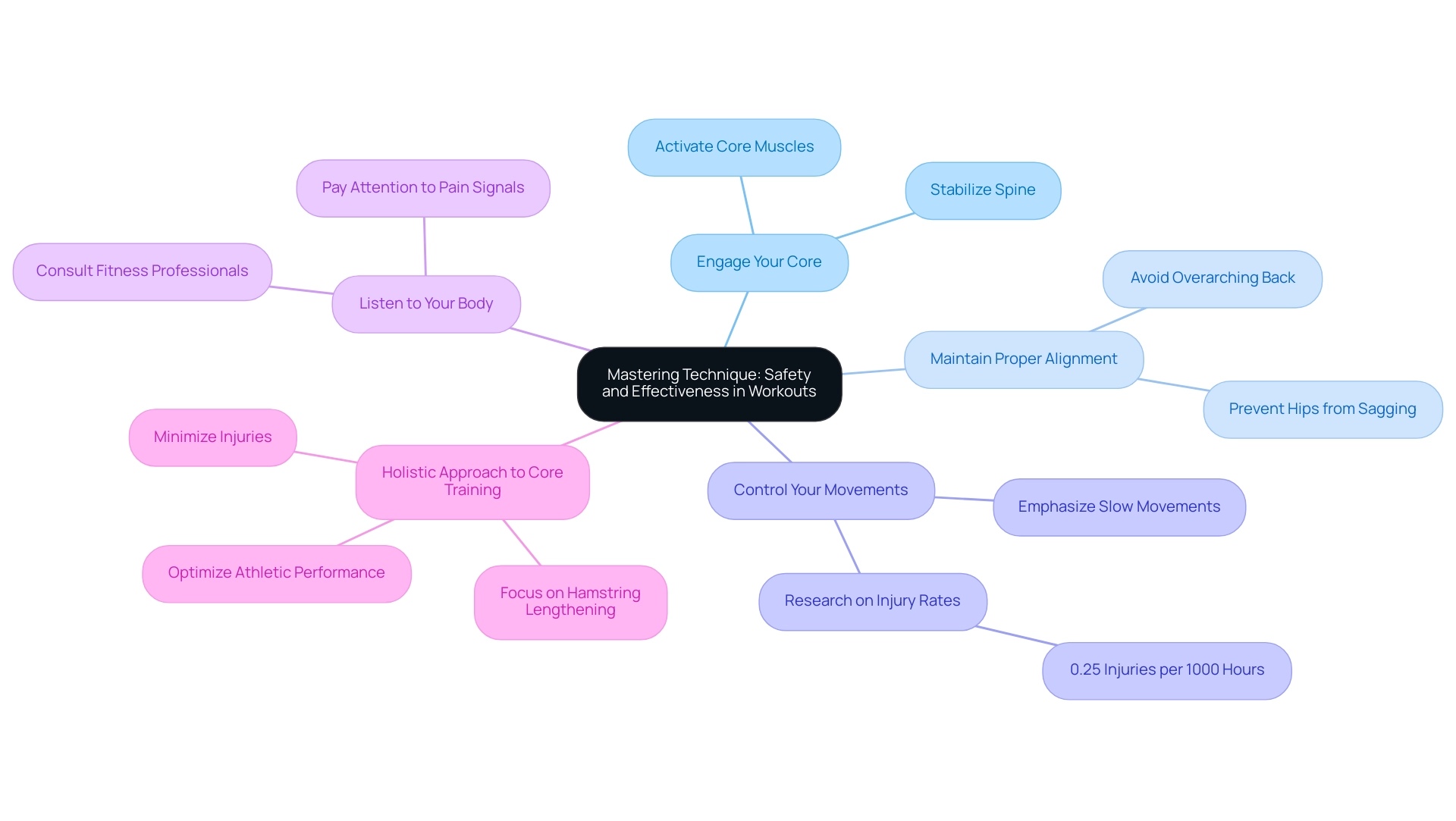
The Importance of Variety: Keeping Your Workouts Engaging and Effective
To enhance engagement in your lower ab and oblique workouts, consider implementing the following dynamic strategies:
- Mix Up Your Exercises: Regularly rotate exercises to target muscles from different angles. For instance, alternate between traditional crunches, hanging leg raises, and stability ball routines. This lower ab and oblique workout not only aids in muscle growth but also keeps exercise sessions fresh and exciting. Research suggests that increasing exercise equipment variety may improve exercise adherence, making this strategy particularly beneficial.
- Vary the Intensity: Introduce high-intensity interval training (HIIT) alongside your traditional exercises. This combination not only amplifies calorie burn but also keeps your body challenged, preventing plateauing in progress.
- Change Your Environment: Shift your exercise scenery by performing activities in various locations, such as parks or fitness studios. Outdoor environments can greatly enhance motivation levels and make exercise more enjoyable.
- Set New Goals: Establish both short-term and long-term fitness objectives to fuel your motivation. Acknowledging and celebrating small achievements along the way can help maintain enthusiasm and commitment to your fitness journey. As Christopher Janelle, Assistant Professor in UF’s Department of Exercise and Sport Sciences, notes, "In fact, you can usually vary things within that particular exercise to keep it interesting."
By embracing variety, you can invigorate your exercise routine, making your fitness journey not only effective but also enjoyable and fulfilling. The insights from a case study on hypertrophy and strength training also demonstrate that varying exercises can lead to increased motivation and effectiveness, reinforcing the value of these strategies.
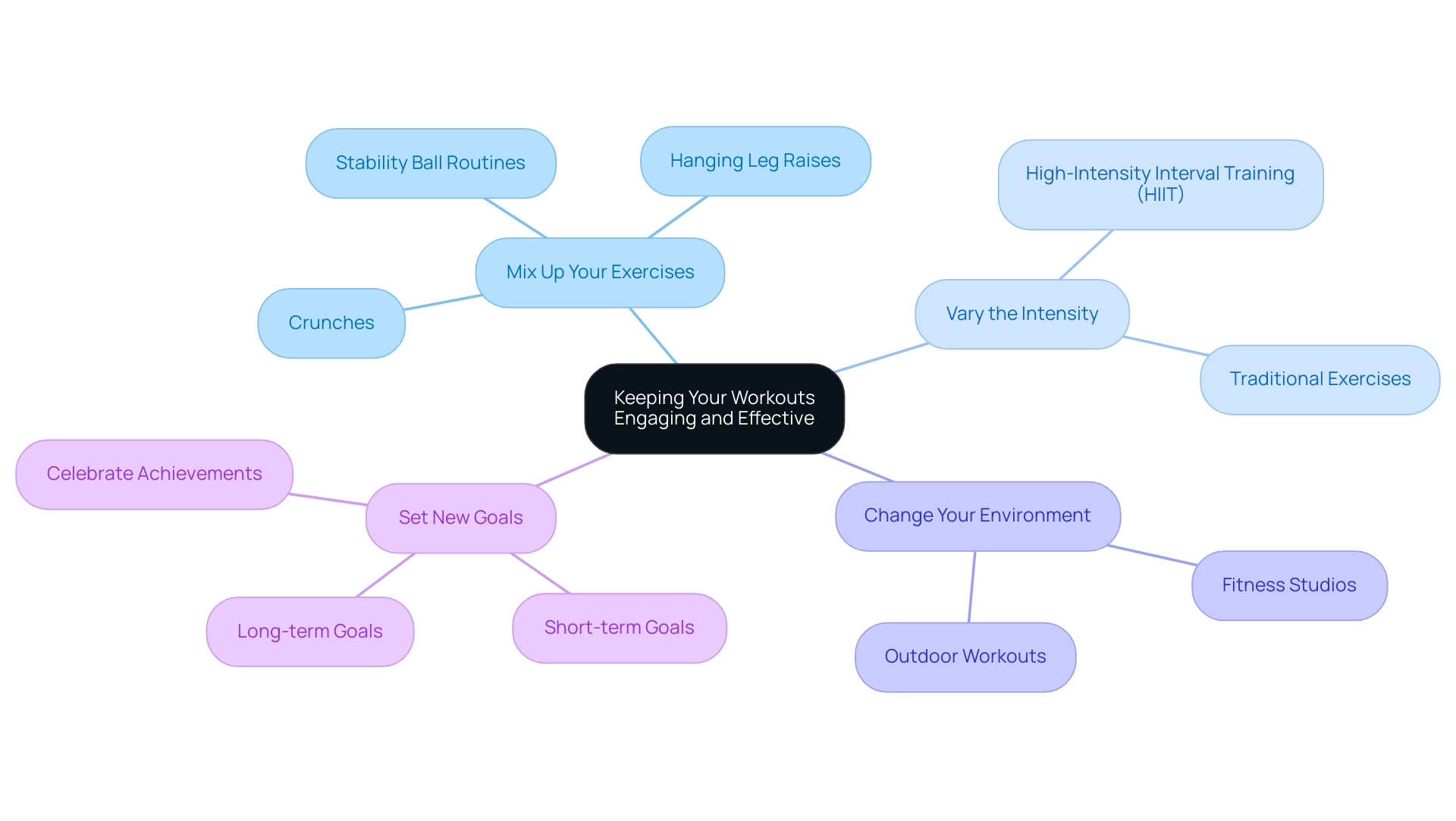
Nutrition and Recovery: Supporting Your Lower Ab and Oblique Training
To optimize your lower ab and oblique training, it’s crucial to embrace effective nutrition and recovery strategies:
- Balanced Diet: A well-rounded diet is essential. Incorporate a variety of protein sources, healthy fats, and complex carbohydrates. Protein is essential for tissue repair, while healthy fats and carbohydrates provide the required energy for your exercises. As Geoff Lecovin states, "optimum protein consumption is key to stimulating muscle protein synthesis and facilitating repair." This reinforces the importance of including sufficient protein in your diet.
- Hydration: Maintaining proper hydration levels is non-negotiable. Ensure you are drinking enough water before, during, and after your exercise sessions. Hydration is not only essential for peak performance but also plays a significant role in recovery. Recent findings highlight that adequate hydration can enhance workout performance and speed up recovery times following intense training sessions.
- Post-Workout Nutrition: To kickstart recovery, aim to consume a meal or snack rich in protein and carbohydrates within 30 minutes post-exercise. Ideal options include a protein shake blended with fruits or a turkey sandwich on whole-grain bread. Studies suggest that consuming 50 g of carbohydrates alongside protein can greatly decrease tissue breakdown, further highlighting the significance of post-workout nutrition. This aligns with the key point that emphasizes the role of specific nutrient intake in recovery.
- Rest and Recovery: Don’t underestimate the power of rest. Schedule recovery days to allow your muscles to heal and grow stronger. Incorporating stretching and foam rolling into your routine can alleviate soreness and enhance flexibility, setting the stage for improved performance in future exercise sessions. Additionally, insights from the case study titled "An Injured Healthcare System Physical Therapy Can Treat: Part 1" highlight the critical role of physical therapy in recovery, demonstrating how targeted interventions can support your fitness journey.
By prioritizing these nutrition and recovery strategies, you can elevate your performance in workouts targeting the lower ab and oblique areas while supporting your overall fitness journey. Remember, every effort you make towards enhancing your team’s well-being reflects your commitment to their health and performance.
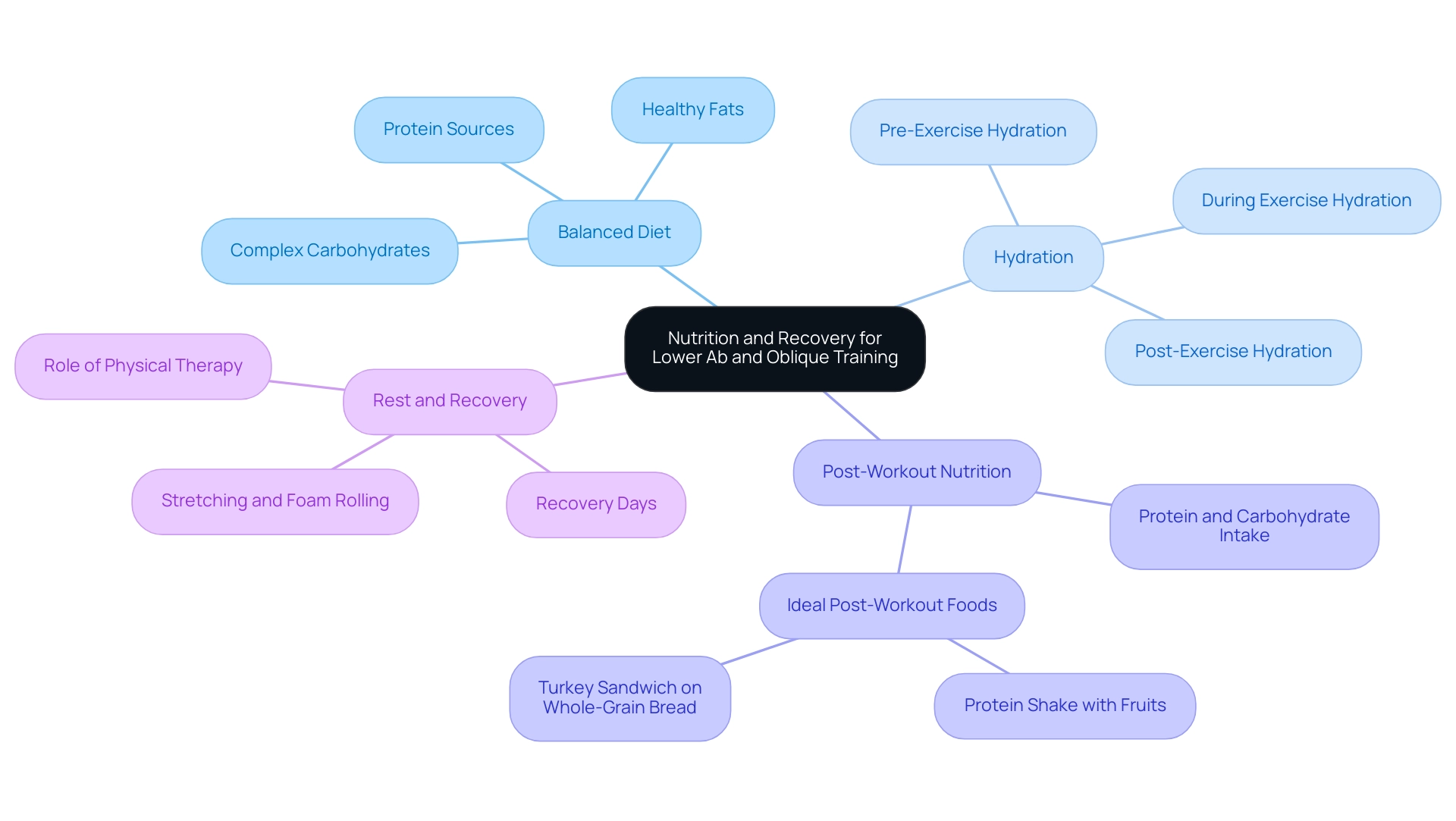
Conclusion
Understanding the intricate anatomy of the core is fundamental to achieving fitness success and overall well-being. By focusing on key muscle groups such as the rectus abdominis, transverse abdominis, and obliques, individuals can enhance workout effectiveness and foster better posture. Incorporating targeted exercises like:
- Reverse crunches
- Bicycle crunches
- Side planks
not only strengthens these areas but also emphasizes the importance of proper technique and variety in workouts.
Moreover, the significance of nutrition and recovery cannot be overstated. A balanced diet rich in protein, adequate hydration, and post-workout nutrition are essential components that support muscle repair and overall performance. Coupled with strategic rest and recovery practices, these elements contribute significantly to fitness success.
As individuals commit to prioritizing their core training and overall health, they pave the way for a stronger, more resilient body. By embracing these strategies, not only is personal performance enhanced, but a culture of well-being is cultivated—one that can inspire teams and communities alike to thrive in their fitness journeys. The time to take action is now; every step taken towards strengthening the core translates into a more empowered and healthier lifestyle.
Frequently Asked Questions
What are the main muscle groups involved in lower ab and oblique workouts?
The main muscle groups include the rectus abdominis, transverse abdominis, internal and external obliques, and pelvic floor tissues.
What is the function of the rectus abdominis?
The rectus abdominis, commonly known as the 'six-pack', is crucial for flexing the spine and stabilizing the torso, contributing to overall core strength.
How does the transverse abdominis support the body?
The transverse abdominis is the deepest layer of abdominal tissues, providing stability and support to the spine and pelvis, acting as a protective layer during exercises.
What role do the obliques play in physical movements?
The internal and external obliques are essential for trunk rotation and lateral flexion, which are important for twisting or bending movements.
Why is it important to understand these muscle groups when training?
A comprehensive understanding of these muscles enhances workout effectiveness, improves posture, and boosts overall fitness.
What exercises can effectively target the lower abs and obliques?
Effective exercises include reverse crunches, bicycle crunches, plank with hip dips, and side planks.
How should reverse crunches be performed?
Lie on your back with knees bent at a 90-degree angle, engage your lower abs to lift your hips off the ground, curl your pelvis toward your chest, then lower back down. Repeat for 10-15 reps.
What is the technique for bicycle crunches?
Lie on your back with hands behind your head and legs lifted. Bring your right elbow toward your left knee while straightening your right leg, then alternate sides in a pedaling motion for 15-20 reps.
How do you perform a plank with hip dips?
Start in a plank position on your forearms, rotate your hips to one side, dip them toward the floor, return to center, and repeat on the opposite side for 10-15 dips on each side.
What is the proper way to do a side plank?
Position yourself on your side, supporting your body with your elbow, lift your hips off the ground to form a straight line from head to heels, and hold for 20-30 seconds on each side.
How often should lower ab and oblique workouts be performed for best results?
It is recommended to incorporate lower ab and oblique workouts into your routine 2-3 times a week for optimal results.
What additional considerations should be taken into account for effective training?
Consistency is key, and incorporating a variety of exercises can enhance the effectiveness of your workout regimen.

